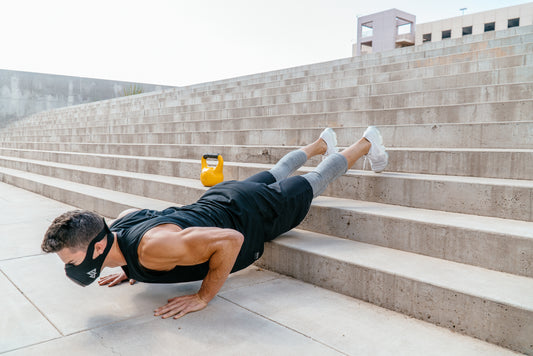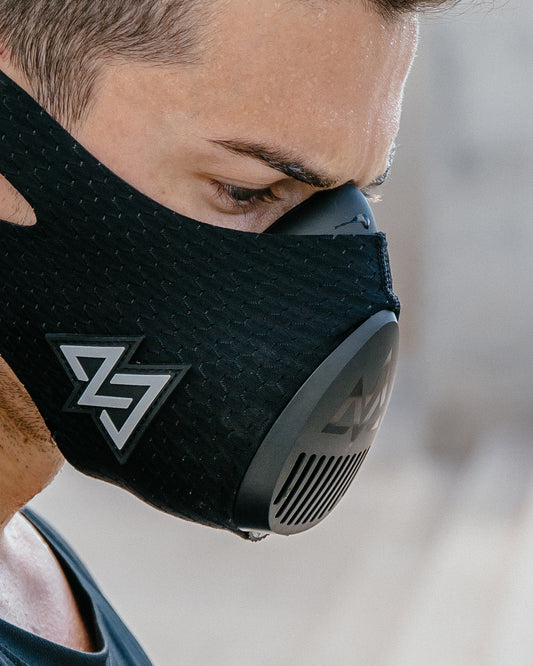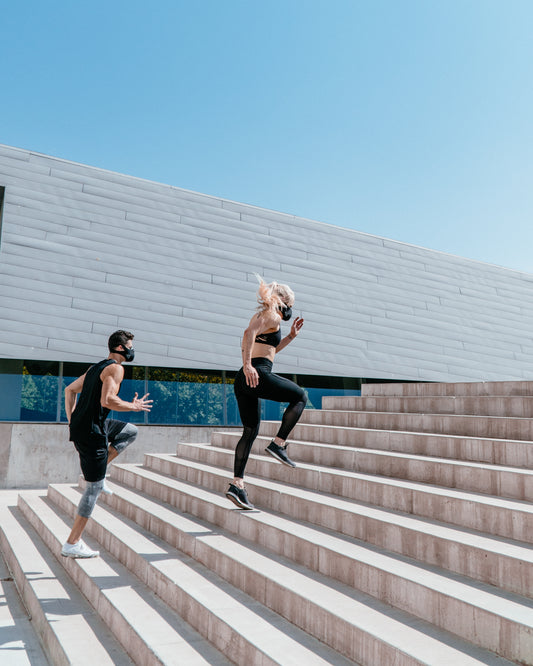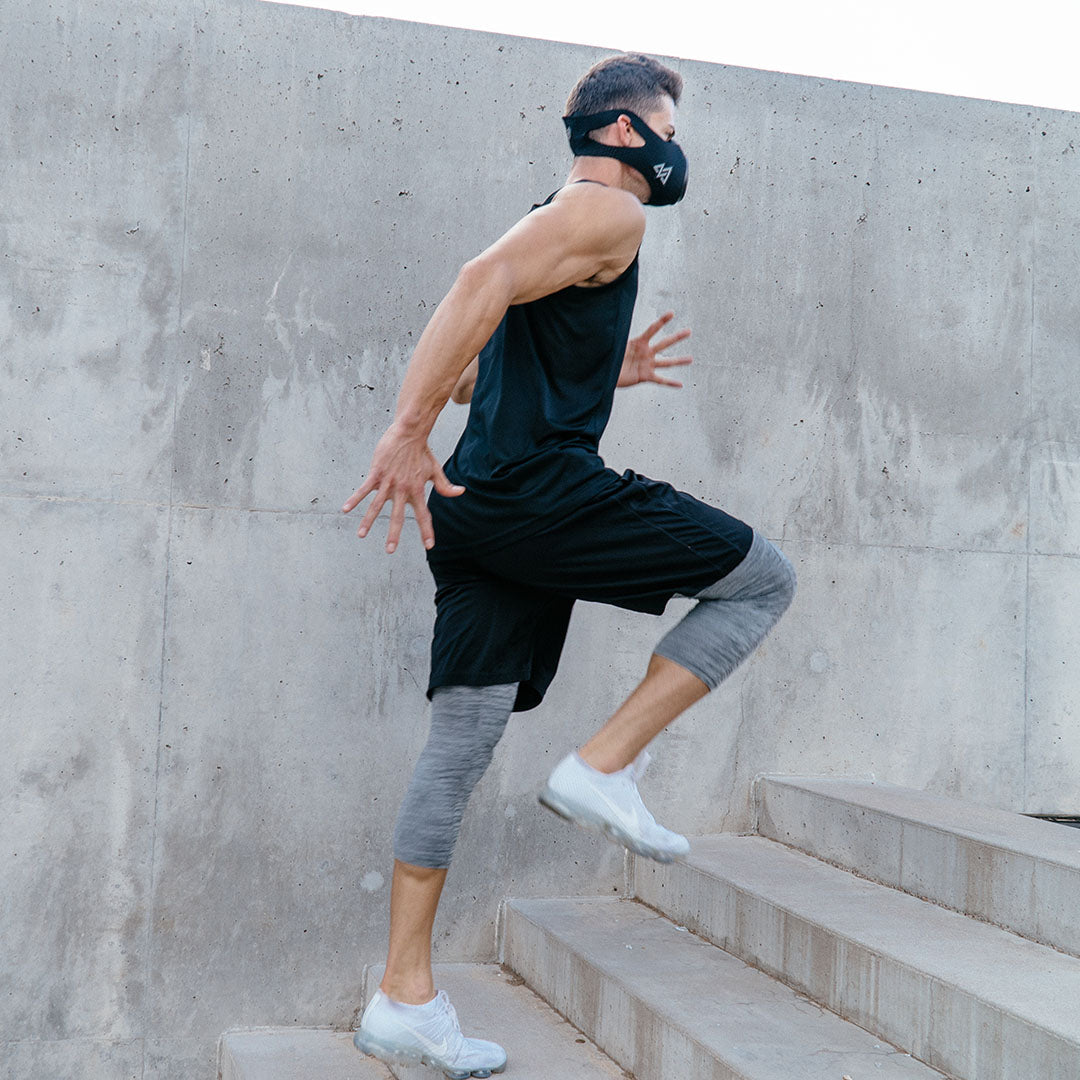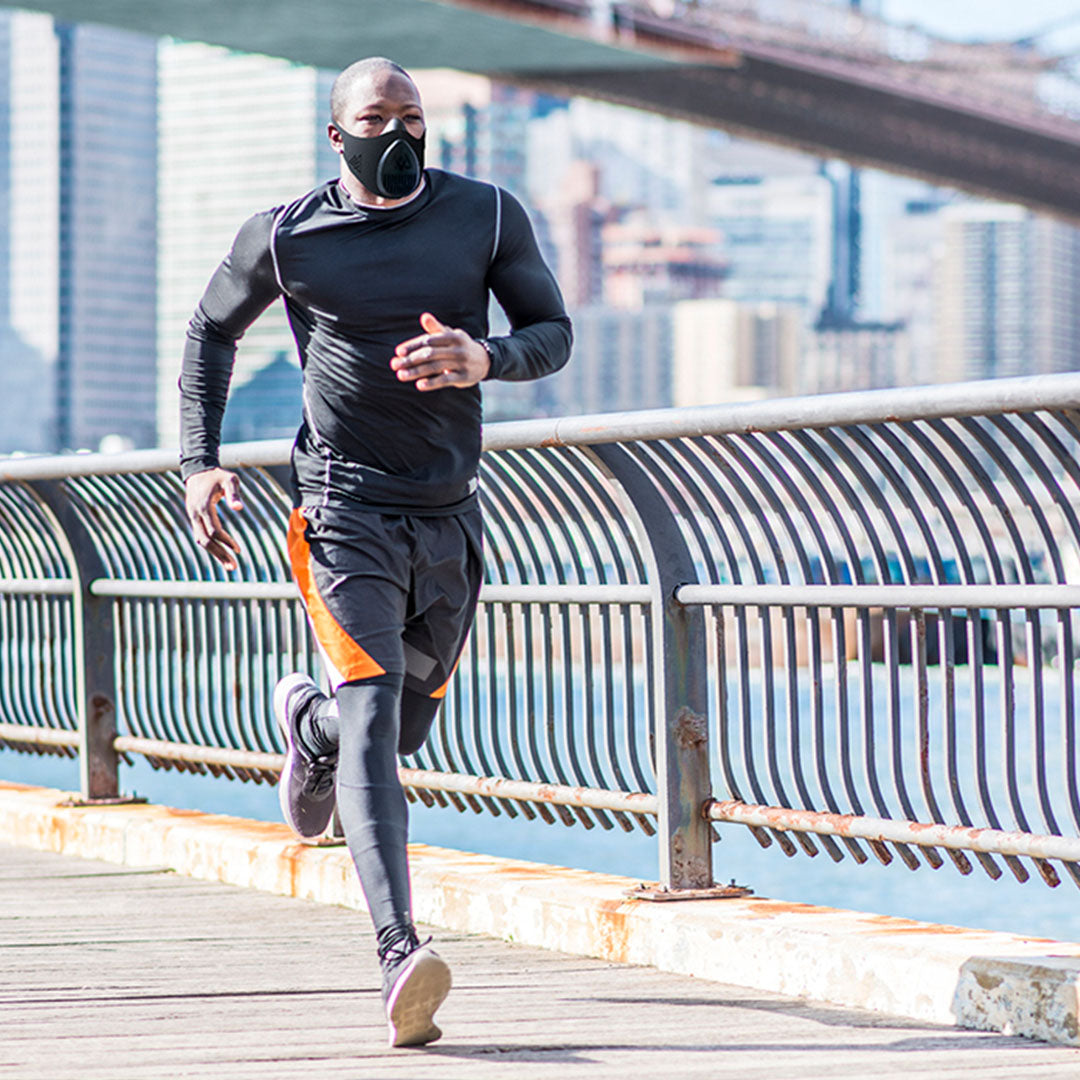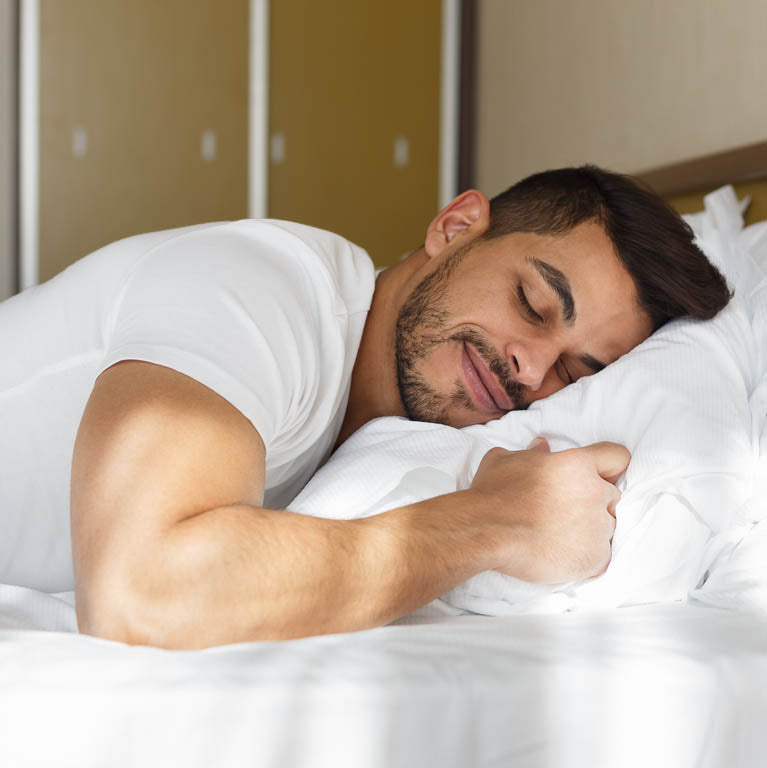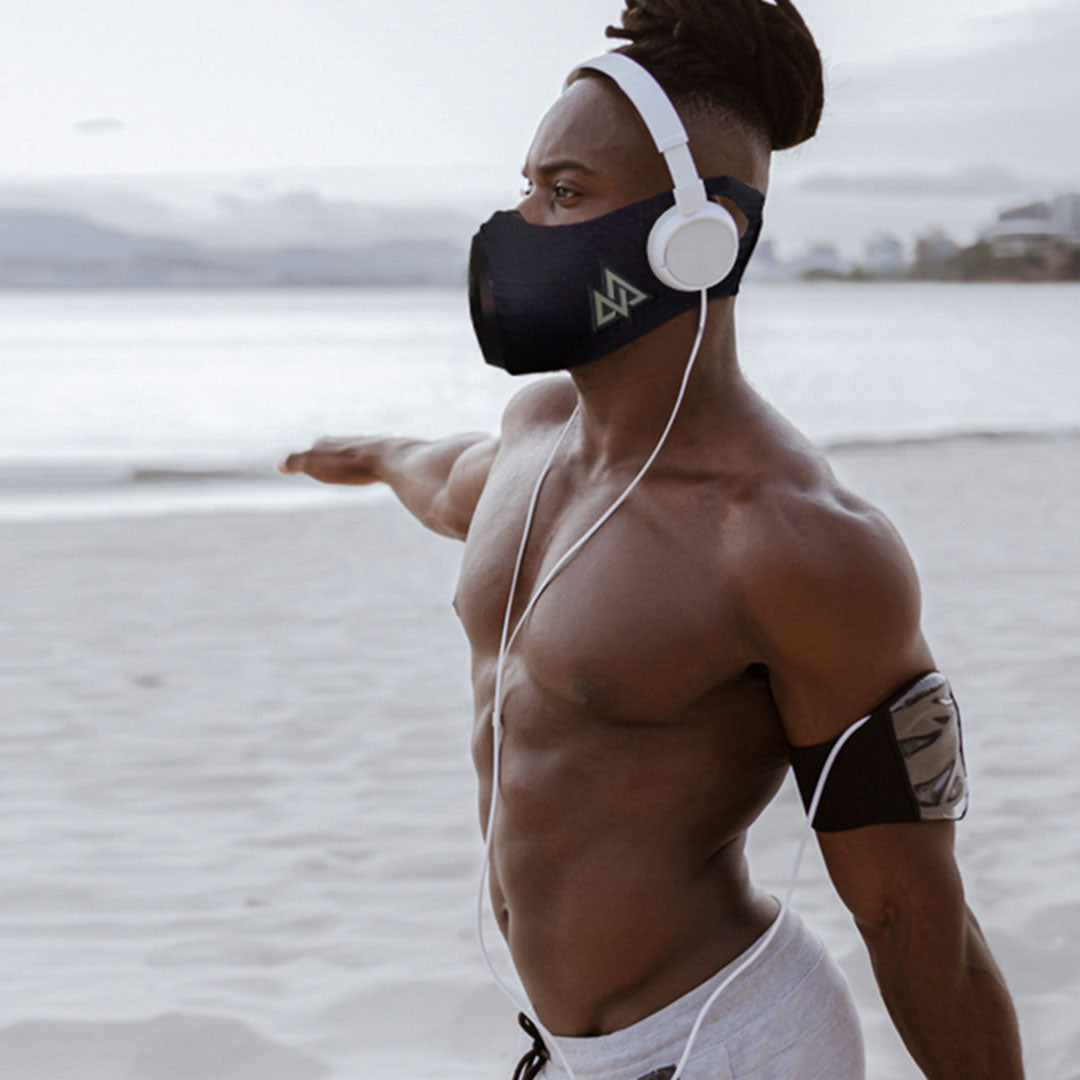This study examined the acute effects of the elevation training mask (ETM) on hemodynamics and heart rate variability (HRV) at rest, during cycling, and recovery in healthy adults. Fifteen healthy male (N=9) and female (N=6) adults (27.0 ± 1.14 years) completed two trials with the mask (MASK) and without the mask (CON). The 40-minute cycling exercise protocol included 10-minute phases of (1) rest, (2) 50% of VO2peak cycling, (3) 70% of VO2peak cycling, and (4) recovery. Blood pressure and pulse oximetry saturation (SPO2) were measured at each phase. An Actiwave-Cardio ECG monitor (CamNtech, UK) was used to measure HRV variables including time and frequency domains. A greater response in systolic blood pressure (p=.035) was observed while SPO2 (p=.033) was lower. The HRV indices were not different between trials during cycling. However, heart rate (p=.047) and inter beat interval (p=.05) were greater while sympathovagal balance (the ratio between low frequency and high frequency; ln LF/HF) was lower in the MASK than CON trial during recovery (p=.01). Wearing an ETM during high intensity cycling (70% of VO2peak) induces modest hypoxemia. Although this device did not affect HRV changes during cycling, it seems to delay the cardiac-autonomic recovery from exercise. Healthy adults may be required to perform high intensity exercise with ETM to simulate hypoxic environment, but future studies are needed whether repeated exposure of this condition provide the similar benefits of altitude training.
Introduction
Inspiratory muscle weakness is associated with slow oxygen uptake kinetic, lower limb muscle weakness, and exercise intolerance [1]. It has been also identified as a limiting factor for exercise performance in patients and sedentary individuals [2,3]. Respiratory muscle training (RMT) has been introduced as a clinical approach for those with chronic heart failure, cardiopulmonary disease, as well as the elderly, to improve their inspiratory muscle strength, exercise tolerance, and quality of life [4,5]. RMT is designed to reduce perceived breath effort and breath work, which results in the delay of respiratory muscle fatigue and attenuation of the respiratory muscle metaboreflex [6]. RMT has known to provide health benefits on hemodynamics and autonomic regulations, which may result in decreasing resting sympathetic activity in addition to baroreceptor sensitivity and sympathovagal balance improvements [7].
Traditionally, RMT is performed at rest and mainly applied to patients for improvements in disease outcomes or quality of life [4,5], but in recent years exercise scientists have begun to consider the role of RMT during exercise and its value as a synergetic benefit on improvements in health and performance. The Elevation training mask (ETM 2.0, Training Mask LLC, Cadillac, Michigan, USA) was introduced in the commercial fitness market and is purportedly designed for the simulation of altitude training. The adjustable resistance cap provides different inspiratory resistance loads that is claimed as an “altitude resistance,” which ranges from 914 m to 5,486 m. A previous study reported that additional RMT training (2 times/week) combined with conventional training improved rowing performance in female competitive rowers, both in a 6 min all-out and a 5,000 m trial [8]. Even though RTM combined with training showed performance improvement, the different equipment (i.e., manufacture or model) may have caused different outcomes on performance improvement. Recently, two studies that utilized the ETM 2.0 device during high intensity cycling exercise or physical training did not show aerobic performance improvement in healthy adults and ROTC cadets, respectively [9,10]. Although many athletes in American football, various types of martial arts, and CrossFit use this equipment during high intensity aerobic or resistance training, it is still unclear whether this equipment truly provides synergetic benefits on health and performance.
In this context, we believe the understanding about physiological responses to wearing an ETM during exercise is important not only to assess possibility as a prospective ergogenic-aid, but also to design ETM-utilized exercise protocols. Heart rate variability (HRV) assessments would provide information on how cardiac auto-regulation is altered by wearing the ETM at rest, during exercise, and recovery because HRV indices reflect the extrinsic regulation of heart rate that involves sympathetic, para-sympathetic activities, and sympathovagal balance [11]. Therefore, the purpose of this study was to examine the acute effects of the ETM on hemodynamics and HRV at rest, during cycling, and recovery. It was hypothesized that ETM would show significant differences in blood pressure, oxygen saturation level (SPO2), and HRV responses compared to control trial without ETM.
Methods // Subjects
Initially, 20 healthy male and female adults enrolled in this study. All participants were recruited by advertisements such as flyers and oral presentations in the University. Inclusion criteria of this study are as follows: 1) participants who were aged between 20-40 years, 2) able to participate cycling exercise, and 3) body fat percentage of under 30%. If participants fell outside these parameters and/or had cardiopulmonary-related diseases, they were excluded. This study was approved by the University’s Institutional Review Board (IRB) and all participants received information of the study procedure, benefits, and risks of the experiment before providing written consent. During the study period, five participants dropped out for personal reasons. Therefore, 15 participants (male, n=9, female, n=6) completed this study. Participants’ basic characteristics are presented in Table 1.
This study was conducted in a randomized and crossover design. Participants reported to the human performance lab three times during the study period. In the first visit, participants’ height, body weight, body fat percentage, respiratory function, and VO2peak were measured to assess basic characteristics. In the second and third visits, participants randomly completed two trials of cycling exercise protocols with or without an ETM. Forty minutes of cycling exercise protocol included 10 minutes of 1) resting, 2) 50% of VO2peak cycling, 3) 70% of VO2peak cycling, and 4) recovery, with a seven-day interval between trials. During this seven-day interval, participants were asked to carry on their normal activities and do not change any exercise habits. Heart rate, blood pressure, SPO2, heart rate variability, self-perceived fatigue and self-perceived breath efforts were measured at each phase. The study procedure is shown in Figure 1.
Methodology
Height, body weight, and body fat percentage. Height and body weight were measured to the nearest 0.1 cm and 0.1 kg, respectively with a stadiometer (PAT #290237, Novel Products, Rockton, USA) and a digital scale (HD-366, Tanita, Japan). Three sites of skinfold thickness were measured by one trained researcher using Lange skinfold calipers (Beta technology, Santa Cruz, CA, USA) to estimate body fat percentage. Three sites of males were chest, abdominal, and thigh while females were triceps, suprailiac, and thigh. Each site was measured three times at the right side of the body, and average score was recorded. Body density was calculated by using the Jackson Pollock method [12] and body fat percentage was estimated by the Siri equation [13].
Respiratory function. Respiratory function test was measured by an electronic spirometer (MicroLabTM, CareFusion, USA). The test is purportedly performed to examine respiratory diseases such as asthma and chronic obstructive pulmonary disease (COPD). If any subjects who had symptoms of airflow obstruction (i.e., ratio of forced expiratory volume in one second (FEV1) / forced vital capacity (FVC) < 0.7, FEV1 % predicted < 80%), they were excluded from the study [14]. Participants first sat in a chair for 5 minutes before they started the test. After 5 minutes, participants put on a nose clip and a spirometer mouthpiece. The respiratory function test consists of 1) three normal breaths, 2) a maximal deep inhalation followed by a 3) forceful exhalation, and 4) three more normal breaths. All participants were tested three times, and the highest scores of FEV1 and FEV1/FVC were recorded.
Blood pressure and SPO2. Blood pressure and SPO2 were measured once at rest, during cycling (50% and 70% of VO2peak), and during recovery. Blood pressure was measured with a mercurial sphygmomanometer (BMS 12-525, Graham Field Inc., USA) by a trained technician, and SPO2 was measured with a pulse oximetry saturation analyzer (Checkmate, Israel). The values were recorded by one mmHg and percentages, respectively.

Peak oxygen uptake test. Participants performed a VO2peak test on a cycle ergometer (894E, Monark, Sweden) while interfaced with a True-One 2400 metabolic cart (ParvoMedics, East Sandy, Utah, USA) to accurately prescribe exercise intensities for the cycling exercise. Participants performed cycling with an initial work rate equal to 60 W (1 Kp) and a pedaling rate of 60 revolutions per minute (RPM) for 2 minutes. Thereafter, the work rate increased by 30 W (0.5 Kp) every 2 minutes until the participant reached exhaustion. VO2peak was determined when participants met at least 2 of the following conditions; (a) inability to keep up the pedaling rate of 60 rpm for more than 5 seconds with verbal encouragement, (b) respiratory exchange ratio (RER) .1.10, (c) rating of perceived exertion (RPE) ≧19 (Borg 6–20 scale), or (d) volitional fatigue.
Heart rate variability. Participants were instructed not to drink any caffeine-contained product at least 24 - 48 hours before any of the tests. An Acti-Cardio monitor (CamNtech, UK), which traces the electro cardiograph (ECG), measured the HRV variables using two electrodes adhered to the participant’s upper chest (5th intercostal space and 10cm away on the left side near the Lead four and five) (Figure 2) [15,16]. Sample rate and resolution were set at 1,024 Hz with 10 bit. Participants’ ECGs were recorded for 40 continuous minutes for all phases of the test. For HRV analysis, a 5-minute period of each phase free of noise was selected according to the task force criteria of the European Society of Cardiology [17] and data was analyzed using the Activewave-Cardio Analysis software program (version 3.0.8, CamNtech, UK). The HRV variables reported with time included average heart rate, inter beat interval (IBI), standard deviation of the IBI interval (IBISD), and root mean squared successive difference (RMSSD). Those reported with frequency domains included low frequency (LF), high frequency (HF), and the ratio between LF and HF (LF/HF ratio).
Cycling exercise. Prior to cycling exercise, participants sat quietly on a chair for 10 min as a rest phase, then performed the cycling exercise (Mornark 894E, Sweden) for 20 min at two different intensities: 50% of VO2peak for the first 10 min and 70% of VO2peak for following 10 min. The average loads of 50% and 70% VO2peak were 1.4 ± 0.37 Kp and 2.1 ± 0.55 Kp, respectively. Participants maintained a pedaling rate of 60 RPM during cycling. After completion of cycling, participants sat on the chair for 10 min as a recovery phase.

Elevation training mask. Elevation training mask (ETM 2.0, Training Mask LLC, Cadillac, Michigan, USA) is a device on the commercial fitness market that claims to improve athletic performance by simulating training at altitude via restricting airflow. The ETM covers the nose and mouth with a neoprene band and flux valves that adjust the resistance of the respiration. There are four different type of plastic resistance caps (i.e., 8, 4, 2, and 1-hole open caps) with the smaller air hole caps in the flux valves causing increased resistance, which making it more difficult to breathe while wearing the mask and thereby simulating higher altitude. In the current study, the ETM mask was adjusted to simulate an altitude resistance of 1,829 m.
Statistical analysis
Statistical analyses were performed with SPSS software version 25.0 (SPSS Inc. Chicago, IL, USA). All data expressed by means and standard errors. Kolmogorov-Smirnov tests were used to analyze the normal distributions of dependent variables. If any dependent variables were not normally distributed, a natural logarithmic transformation were performed to meet the assumptions of parametric statistical analysis. 2 (trial) x 4 (time) factorial analysis of variances (ANOVAs) for repeated measures were used to assess the effects of wearing an ETM on blood pressure, SPO2, heart rate variability, and self-perceived fatigue and breath effort. If any significant interaction or main effects were detected, Tukey’s HSD post-hoc tests were applied. Significance level was set at .05 for all tests.
Results
Changes in hemodynamics
The changes of blood pressure and SPO2 are presented in Table 2. There were no significant interaction effects for group by time in blood pressure, p > .05. However, the systolic BP was greater in the MASK than CON trial at rest (p=.035). Regarding SPO2, there was a significant interaction effect for group by time (p=.033). SPO2 level was significantly lower in the MASK than the CON trial during high intensity cycling (70% of VO2peak).
Changes in heart rate variability
Table 3 presents the changes of HRV indices with time and frequency domains. The HRV indices were not significantly different between trials at rest and during cycling. However, heart rate (p=.047) was significantly greater while IBI (p=.05) was lower in the MASK than the CON trial during recovery. Regarding frequency domains, the lnLF/HF ratio was significantly lower in the MASK than the CON trial during recovery (p=.01). However, no significant interaction or group effects were observed in lnLF and lnHF. The HRV indices including time and frequency domains were significantly changed across the time in both trails (p<.001).
Changes in self-perceived fatigue and breath effort
There were no significant interaction effects for group by time on RPE and RPBE during the study. RPE (F=24.43, p<.001) and RPBE (F=70.83, p<.001) increased significantly as cycling intensity increased in both trials, but the RPBE was greater in the MASK than CON trial across the time (F=40.18, p<.001).
Discussion
Elevation training masks have been widely used in the athletic and recreational communities. Although the company claims the increase in respiratory load, known as ‘altitude resistance’, improves respiratory muscle weakness and aerobic performance, it is unknown how cardiovascular function is altered in response to wearing an ETM during exercise and recovery. This study examined the acute effect of wearing the ETM on hemodynamics and HRV at rest, during cycling, and during recovery in healthy adults. Main findings of the study were as follows; 1) a greater response in systolic BP was observed while SPO2 was lower in the MASK compared to the CON trial, 2) The HRV indices were not different between trials during cycling, but heart rate and IBI were greater, 3) sympathovagal balance (lnLF/HF ratio) was lower in the MASK than the CON trial during recovery, and 4) perceived breath effort was greater in the MASK than CON trial across all time points.
Hemodynamic changes
In the present study, a greater response in systolic BP was observed in the MASK trial, while SPO2 was lower in the MASK than the CON trial. Cardiovascular functions are interactively adjusted in response to respiratory function changes, such as breath frequency. The increase in respiratory load reduces the breath frequency rate, and this change influences the kinetics of oxygen consumption and CO2 expiration [18]. It is commonly accepted that acute exposure at high altitude (>3,000 m) immediately increases the ventilation and decreases arterial partial pressure of oxygen due to low partial pressure of oxygen [19]. As opposed to altitude exposure, Grandos and colleagues reported the increase in respiratory load during steady state exercise did not increase the ventilation rate, but increased respiratory load may change metabolic CO2 in the respiratory track without significant changes in oxygen consumption kinetics [18]. This perhaps influenced the ventilatory equivalent as well as affected the decrease in peripheral oxygen saturation level. The current study also revealed a similar pattern with the previous study, but the post-hoc test showed that SPO2 level was significantly lower only during high intensity cycling. The differences between the present and previous studies may be associated various factors such as different altitude resistance (1860 m vs 2743 m, 4572 m), subjects (both male and female vs male alone), exercise type (cycling vs treadmill), and intensity (50% and 70% vs 60% of VO2peak). Additionally, it was assumed that respiratory function may not be a limiting factor for peripheral oxygen carrying capacity at rest or during moderate intensity cycling in healthy adults despite the loaded respiration. However, the increased respiratory load during high intensity cycling may be less sufficient for the kinetics of oxygen consumption to meet the exercise demands in working muscle (i.e., metabolic demands), thus it can be postulated that wearing an ETM during high intensity cycling induces modest arterial hypoxemia in healthy adults. Despite EMT inducing modest arterial hypoxemia, it is difficult to confirm that this device could provide similar benefits of altitude training on hematological changes such as increased red blood cell and EP-O concentration. A previous study reported that exposure of hypoxic condition with ETM for 60 minutes per week for 6 weeks was not sufficient to change the hematological variables [9]. Another study also reported that 6 weeks of physical training with ETM did not improve aerobic capacity in ROTC cadets [10].
Heart rate variability
The present study hypothesized that wearing an ETM during cycling would greatly influence HRV compared to not wearing an ETM. Although HRV indices were not different between the trials at rest and during cycling, heart rate and IBI were significantly greater in MASK than CON trial during recovery. It has been demonstrated that respiration plays an important role in modulating HRV as well as baroreflex [20]. The increase in respiratory resistance changes the inspiration process from passive to active, which results in recruiting additional respiratory muscle group (i.e., sternocleidomastoid) [21]. Along with the additional muscle recruitments, slow oxygen consumption kinetics with loaded respiration may change the signaling in the central cardiovascular center that results in increasing heart rate and blood pressure. Another explanation may involve the intensive activation of the diaphragm metaboreflex that can lead to increased sympathetic activity [22]. In agreement with our results, McConnell and Griffiths found that 30% of maximal inspiratory pressure increased HR and blood pressure in healthy males [23].
Regarding frequency domains, the lnLF and lnHF powers decreased as cycling intensity increased in both trials, but the variables were not different between the MASK and CONT trials in the present study. Traditionally, LF power represents both sympathetic and parasympathetic modulation while HF power indicates parasympathetic activity [11]. It has been demonstrated that autonomic transition occurred toward sympathetic dominance when shifting from rest to exercise, such as cycling.24 Previous studies also reported that frequency domains including LF and HF powers decreased as exercise intensity increased until the heart rate reached between 120 to 180 beat/min [24,25], and this change continued until the first ventilation threshold [26]. Moreno’s study also supports our result that frequency domains of HRV (i.e., LF, HF) is reduced while HR increases during moderate intensity exercise (60% of VO2peak) [27]. However, while the lnLF/HF ratio increased from rest (1.2) to moderate intensity cycling (1.9) in the CON trial, this score did not change in the MASK trial (1.1 at rest and moderate intensity cycling) in this study. It was believed that the sympathetic dominance during moderate intensity exercise caused the increase in LF/HF ratio (sympathovagal balance) due to HF power withdrawal concomitant with increased LF power [28]. As respiratory variation is a primary factor for vagal modulation, it was assumed that ETM-induced longer respiration phase might not diminish the vagal activity. After cycling exercise, lnLF/HF ratio was lower in the MASK than CON trial in this study and this particular finding may be due to the restoration of the HF power from the cycling exercise. Although there was no significant difference in lnHF power between the trials during recovery, the mean lnHF power was greater in the MASK than CON trial (4.2 vs 2.9) whereas the mean lnLF power showed similar values (5.3 vs 4.9). Nevertheless, it is premature to definitively conclude our result is directly related to parasympathetic predominance, but perhaps it is because other physiological variables, including heart rate and IBI, were greater in the MASK than CON trial despite the lower sympathovagal balance during recovery. We carefully assumed that even though extrinsic controls of heart rate (i.e., sympathetic and parasympathetic control) is being changed by ETM, the intrinsic controls of heart rate such as SA node might increase to compensate the changed autonomic regulations to remove the metabolic by-products after exercise. The present study confirms that wearing an ETM delays the cardiac-autonomic recovery from cycling exercise.
Perceived fatigue and breath effort.
Rate of perceived exertion is a practical method to measure fatigue rate during exercise. In the present study, perceived fatigue was not differed between trials, but perceived breath effort was greater in the MASK than CON trials across the time. It was assumed that increased respiratory load decreased ventilation, and decreased ventilation might be associated with psychological discomfort. Our assumption supported by a previous study that perceived breath effort is positively associated with ventilation [29].
Limitations
Some limitations should be considered in this study. First, breath frequency rate was not measured in the present study. Even though previous studies demonstrated the increase in respiratory load reduced breath frequency rate [18], the absence of breath frequency rate measurement may limit to explain the association between breath frequency rate and HRV in this study. Secondly, this study only tested in one condition with altitude of resistance of 1829 m, even though the company introduces various altitude resistance conditions (914 m to 5486 m). Therefore, applying different altitude resistances during exercise may result in different outcomes.
Conclusions
Our findings suggest that wearing an ETM (altitude resistance, 1829 m) during high intensity cycling (70% of VO2peak) induces modest hypoxemia. Although this device does not affect HRV changes during cycling, it seems delay the cardiac-autonomic recovery from exercise. Based on this study, healthy adults may be able to develop the ETM-utilized exercise program to simulate hypoxic environment but future studies are needed whether repeated exposure of this condition provide the similar benefits of altitude training in healthy adults.
Acknowledgement
We would like to thank all the subjects who participated in this study.
Disclosure statement
No potential conflict of interest was reported by the authors
References
1. Wolpat A, Lima FV, Silva FM, et al. Association between inspiratory muscle weakness and slowed oxygen uptake kinetics in patients with chronic obstructive pulmonary disease. Appl Physiol Nutr Metab. 2017;42(12):1239-1246.
2. Charususin N, Dacha S, Gosselink R, et al. Respiratory muscle function and exercise limitation in patients with chronic obstructive pulmonary disease: a review. Expert Rev Respir Med. 2018;12(1):67-79.
3. Langer, D. Inspiratory Muscle Training. In Textbook of Pulmonary Rehabilitation (pp. 233-249). Springer, Cham; 2018.
4. Archiza B, Simões RP, Mendes RG, Fregonezi GA, Catai AM, Borghi-Silva A. Acute effects of different inspiratory resistive loading on heart rate variability in healthy elderly patients. Braz J Phys Ther. 2013;17(4):401-408.
5. Mello PR, Guerra GM, Borile S, et al. Inspiratory muscle training reduces sympathetic nervous activity and improves inspiratory muscle weakness and quality of life in patients with chronic heart failure: a clinical trial. J Cardiopulm Rehabi Prev. 2012;32(5):255-261.
6. Witt JD, Guenette JA, Rupert JL, McKenzie DC, Sheel AW. Inspiratory muscle training attenuates the human respiratory muscle metaboreflex. J Physiol. 2007;584(3):1019-1028.
7. Jaenisch RB, Quagliotto E, Chechi C, et al. Respiratory muscle training improves chemoreflex response, heart rate variability, and respiratory mechanics in rats with heart failure. Can J Cardiol. 2017;33(4):508-514.
8. Volianitis S, McConnell AK, Koutedakis Y, McNaughton LR, Backx K, Jones DA. Inspiratory muscle training improves rowing performance. Med Sci Sports Exerc. 2001;33(5):803-809.
9. Porcari JP, Probst L, Forrester K, et al. Effect of wearing the elevation training mask on aerobic capacity, lung function, and hematological variables. J Sports Sci Med. 2016;15(2):379.
10. Sellers JH, Monaghan TP, Schnaiter JA, Jacobson BH, Pope ZK. Efficacy of a ventilatory training mask to improve anaerobic and aerobic capacity in reserve officers' training corps cadets. J Strength Cond Res. 2016;30(4):1155-1160.
11. Acharya UR, Joseph KP, Kannathal N, Lim CM, Suri JS. Heart rate variability: a review. Med Biol Eng Comput. 2006;44(12):1031-1051.
12. Jackson AS, Pollock ML. Generalized equations for predicting body density of men. Br J Nutr. 2004;91(1):161-168.
13. Siri WE. Body composition from fluid spaces and density: Analysis of methods. 1961. Nutrition. 1993;9(5):480-491.
14. National Institute for Clinical Excellence. Chronic obstructive pulmonary disease in over 16s: diagnosis and management. Clinical Guideline, 2010;101:23.
15. Bridget A. Actiwave cardio: the feasibility and validation of an innovative new ambulatory. Proceedings of Austrailian Cardiovascular Health and Rehabilitation Association at Brisbane, Australia; 2014.
16. Thompson AG, Swain DP, Branch JD, Spina RJ, Grieco CR. Autonomic response to tactical pistol performance measured by heart rate variability. J Strength Cond Res. 2015;29(4):926-933.
17. Malik M, Bigger JT, Camm AJ, et al. Heart rate variability-standards of measurements, physiological interpretation, and clinical use; Task Force of the European Society of Cardiology. Eur Heart J. 1996;17(3):354-381.
18. Granados J, Gillum TL, Castillo W, Christmas KM, Kuennen MR. “Functional” respiratory muscle training during endurance exercise causes modest hypoxemia but overall is well tolerated. J Strength Cond Res. 2016;30(3):755-762.
19. Helfer S, Quackenbush J, Fletcher M, Pendergast DR. Respiratory muscle training and exercise endurance at altitude. Aerosp Med Hum Perform. 2016;87(8):704–711.
20. Bernardi L, Porta C, Gabutti A, Spicuzza L, Sleight P. Modulatory effects of respiration. Auton Neurosci. 2001;90(1):47-56.
21. Hellyer NJ, Folsom IA, Gaz DV, Kakuk AC, Mack JL, Ver Mulm JA. Respiratory muscle activity during simultaneous stationary cycling and inspiratory muscle training. J Strength Cond Res. 2015;29(12):3517-3522.
22. Sheel AW, Derchak PA, Morgan BJ, Pegelow DF, Jacques AJ, Dempsey JA. Fatiguing inspiratory muscle work causes reflex reduction in resting leg blood flow in humans. J Physiol. 2001;537(1):277-289.
23. McConnell AK, Griffiths LA. Acute cardiorespiratory responses to inspiratory pressure threshold loading. Med Sci Sports Exerc. 2010;42(9):1696-1703.
24. Casties JF, Mottet D, Le Gallais D. Non-linear analyses of heart rate variability during heavy exercise and recovery in cyclists. Int J Sports Med. 2006;27(10):780-785.
25. Povea C, Schmitt L, Brugniaux J, Nicolet G, Richalet JP, Fouillot JP. Effects of intermittent hypoxia on heart rate variability during rest and exercise. High Alt Med Biol. 2005;6(3):215-225.
26. Cottin F, Leprêtre PM, Lopes P, Papelier Y, Médigue C, Billat V. Assessment of ventilatory thresholds from heart rate variability in well-trained subjects during cycling. Int J Sports Med. 2006;27(12):959-967.
27. Moreno IL, Pastre CM, Ferreira C, de Abreu LC, Valenti VE, Vanderlei LCM. Effects of an isotonic beverage on autonomic regulation during and after exercise. J Int Soc Sports Nutr. 2013;10(1):2.
28. Perini R, Veicsteinas A. Heart rate variability and autonomic activity at rest and during exercise in various physiological conditions. Eur J Appl Physiol. 2003;90(3-4):317-325.
29. Suzuki S, Sato M, Okubo T. Expiratory muscle training and sensation of respiratory effort during exercise in normal subjects. Thorax. 1995;50(4):366-370.


